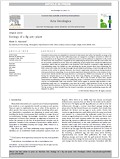| Journal Article |
 |
|
| Article Title | Ecology of a fig anteplant | | Author | Rhett Daniel Harrison | | Year | 2013 | | Journal Title | Acta Oecologica | | Institution | Elsevier Masson SAS. | | Pages | 1-9 | | Call Number | JA0537-14 | | Keywords | Agaonidae, Anteplant, Ficus, Pollinator, Parasitoid, Trophic interactions, Tropical forest |
|
| Abstract: |
| Mutualistic interactions are embedded in networks of interactions that affect the benefits accruing to the
mutualistic partners. Figs and their pollinating wasps are engaged in an obligate mutualism in which the
fig is dependent on the fig pollinator for pollination services and the pollinator is dependent on fig ovules
for brood sites. This mutualism is exploited by non-pollinating fig wasps that utilise the same ovules, but
do not provide a pollination service. Most non-pollinating wasps oviposit from outside the inflorescence
(syconium), where they are vulnerable to ant predation. Ficus schwarzii is exposed to high densities of
non-pollinating wasps, but Philidris sp. ants patrolling the syconia prevent them from ovipositing. Philidris
rarely catch wasps, but the fig encourages the patrolling by providing a reward through extra-floral
nectaries on the surface of syconia. Moreover, the reward is apparently only produced during the phase
when parasitoids are ovipositing. An ant-exclusion experiment demonstrated that, in the absence of ants,
syconia were heavily attacked and many aborted as a consequence. Philidris was normally rare on the figs
during the receptive phase or at the time of day when wasp offspring are emerging, so predation on
pollinators was limited. However, Myrmicaria sp. ants, which only occurred on three trees, preyed
substantially on pollinating as well as non-pollinating wasps. F. schwarzii occurs in small clusters of trees
and has an exceptionally rapid crop turnover. These factors appear to promote high densities of nonpollinating
wasps and, as a consequence, may have led to both a high incidence of ants on trees and
increased selective pressure on fig traits that increase the payoffs of the figeant interaction for the fig.
The fig receives no direct benefit from the reward it provides, but protects pollinating wasps that will
disperse its pollen. |
|